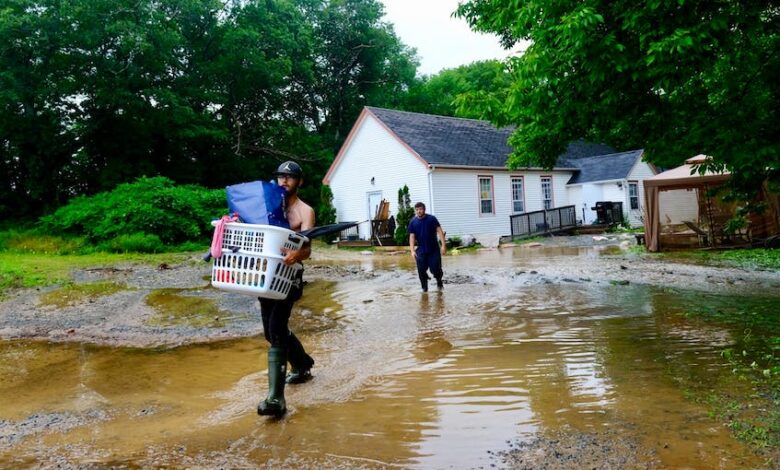Flood insurance coming for all Canadian property owners in 2025

Flood insurance is coming for everyone.
Or rather, a federal program in the works will make flood insurance available to all property owners in Canada.
The caveat of the planned subsidized program for the most flood-prone areas will be that if you don’t buy the insurance, don’t expect disaster assistance funding from the federal government as has been made available to the victims of the July 21-22 flooding in Nova Scotia.
“We know it can’t come quick enough,” said Craig Stewart, vice-president of climate change and federal issues for the Insurance Bureau of Canada.
“The insurance industry is working very closely with (the) federal government to design the program. We’re hoping it could be stood up on April 1, 2025. That’s the target date. Our preference is to create a program that is seamless for consumers. Every homeowner or property owner, whether high risk or not, is offered flood insurance coverage through their regular insurance provider.”
Those in flood-prone areas deemed at the highest risk, many of whom are not currently able to buy flood insurance, will have their premiums subsidized through a Crown corporation that backstops private insurance providers.
The cost of those premiums won’t be known publicly until closer to the program launch date.
A report filed by Canada’s Task Force on Flood Insurance and Relocation last August gave some hints at possible costs by presenting four different models to be chosen from.
In the model closest to what has been chosen by the federal government, the task force gave the example of those at highest risk would be offered flood insurance with an annual premium of $3,000 per year and a maximum coverage of up to $300,000.
Premiums for areas of lower risk would come at a lesser cost.
However, that model also presumed purchasing flood insurance would be mandatory for all property owners in Canada whether they want it or not, thereby seeing those at low risk subsidizing the insurance of those at high risk.
Stewart said what’s in the works moves away from that model, making insurance voluntary.
“Under the program being developed, those at the top of the hill will not be subsidizing those at the bottom of the hill,” said Stewart.

“The government will backstop the risk for those in flood-prone areas so insurers can operate in high-risk areas on a not-for-profit basis.”
According to a written response from Public Safety Canada to The Chronicle Herald’s questions, the backstopping of private insurers will be accompanied by a subsidy to those buying the insurance to make sure it is affordable.
“The government plans to engage provinces and territories on the development and implementation of the low-cost flood insurance program, as well as the requirements for its long-term fiscal sustainability, including cost-sharing and risk mitigation,” reads the response.
Just over $31 million was committed in this spring’s federal budget to build the program.
The payoff for the federal government is it will be able to start backing out of the disaster assistance model. In that existing system, provinces compensate victims of natural disasters and then send a bill to the federal government for partial reimbursement.
“Under the program being developed, those at the top of the hill will not be subsidizing those at the bottom of the hill.”
– Craig Stewart
“This is like the third (Emergency Management Office) event in less than a year,” John Lohr, minister responsible for the office, told The Chronicle Herald after the recent flood.
“Our staff worked very hard to stand this program up in a very short time. We’re starting to get some experience in this.”
In the case of a flood, uninsured homeowners and renters tabulate their losses and submit them to the provincial government. Adjusters are sent out for the program that works like private insurance would, claims are processed and cheques get sent out months later.
Similar responses were initiated for those affected by this spring’s wildfires and hurricane Fiona last fall.
“When I attend federal, provincial and territorial meetings, this is always discussed,” said Lohr of creating affordable, accessible insurance for natural disasters.

“While this is our third emergency event in less than a year, for the federal government it is almost a daily occurrence. They had 200-300 events across the country last year. What they are putting out now through their disaster assistance program is they’re asking themselves if there’s a better way to do that.”
The federal task force’s report noted that the existing system is becoming unaffordable – it anticipated annual costs of $2.9 billion alone. The report states that once the flood insurance program is operational, similar ones will be built to cover damage from wildfires and earthquakes in high-risk areas.
“Today, taxpayers are subsidizing everybody at high risk because governments are using taxpayer money to bail out high-risk homes after every flood event,” said Stewart.
“We need to move from that model to a model where those at high risk are paying for the risk they face. Only then will they and their communities be incentivized to protect themselves.
“Ideally, we want municipalities to start investing in flood defenses and to start preventing new development in high-risk areas.”






